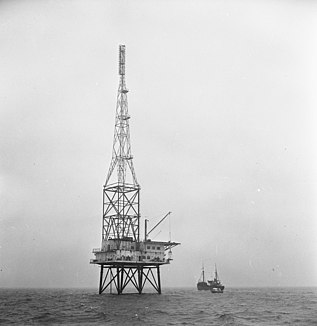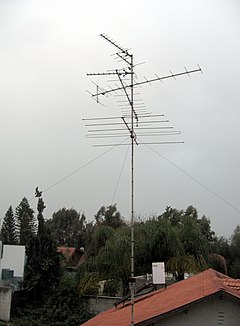
Very high frequency (VHF) is the ITU designation for the range of radio frequency electromagnetic waves from 30 to 300 megahertz (MHz), with corresponding wavelengths of ten meters to one meter. Frequencies immediately below VHF are denoted high frequency (HF), and the next higher frequencies are known as ultra high frequency (UHF).
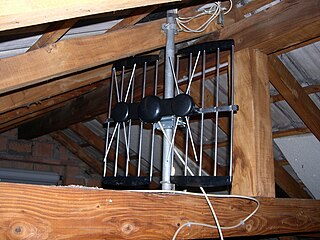
Ultra high frequency (UHF) is the ITU designation for radio frequencies in the range between 300 megahertz (MHz) and 3 gigahertz (GHz), also known as the decimetre band as the wavelengths range from one meter to one tenth of a meter. Radio waves with frequencies above the UHF band fall into the super-high frequency (SHF) or microwave frequency range. Lower frequency signals fall into the VHF or lower bands. UHF radio waves propagate mainly by line of sight; they are blocked by hills and large buildings although the transmission through building walls is strong enough for indoor reception. They are used for television broadcasting, cell phones, satellite communication including GPS, personal radio services including Wi-Fi and Bluetooth, walkie-talkies, cordless phones, and numerous other applications.
Television in the United Kingdom started in 1936 as a public service which was free of advertising. Currently, the United Kingdom has a collection of free-to-air, free-to-view and subscription services over a variety of distribution media, through which there are over 480 channels for consumers as well as on-demand content. There are six main channel owners who are responsible for most material viewed. There are 27,000 hours of domestic content produced a year at a cost of £2.6 billion. Since 24 October 2012, all television broadcasts in the United Kingdom have been in a digital format, following the end of analogue transmissions in Northern Ireland. Digital content is delivered via terrestrial, satellite and cable, as well as over IP.
Television in New Zealand was introduced in 1960 as a state-run service. The broadcasting sector was deregulated in 1989, when the Government allowed competition to the state-owned Television New Zealand (TVNZ). There are currently three forms of broadcast television: a terrestrial (DVB-T) service provided by Freeview; satellite services provided nationwide by both Freeview and Sky; and an internet television service delivered over cable and fibre broadband.
Three is a New Zealand nationwide television channel. Launched on 26 November 1989 as TV3, it was New Zealand's first privately owned television channel. The channel currently broadcasts nationally in digital free-to-air form via the state-owned Kordia on terrestrial and satellite. Vodafone also carries the channel for their cable subscribers in Wellington and Christchurch. It previously broadcast nationally on analogue television until that was switched off on 1 December 2013.

The All-Channel Receiver Act of 1962 (ACRA), commonly known as the All-Channels Act, was passed by the United States Congress in 1961, to allow the Federal Communications Commission to require that all television set manufacturers must include UHF tuners, so that new UHF-band TV stations could be received by the public. This was a problem at the time since the Big Three television networks were well-established on VHF, while many local-only stations on UHF were struggling for survival.
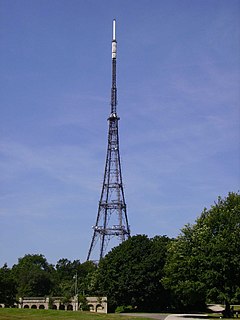
The Crystal Palace transmitting station, officially known as Arqiva Crystal Palace, is a broadcasting and telecommunications site in the Crystal Palace area of the London Borough of Bromley, England. It is located on the site of the former television station and transmitter, operated by John Logie Baird, from 1933.
A UK Restricted Service Licence, is typically granted to radio stations and television stations broadcasting within the UK to serve a local community or a special event. Licences are granted by the broadcasting authority Ofcom.

The Caradon Hill transmitting station is a broadcasting and telecommunications facility on Bodmin Moor in the civil parish of Linkinhorne, located on Caradon Hill, Cornwall, United Kingdom. It is 4 miles (6 km) north of Liskeard, and ¾ mile (1.25 km) south-east of Minions, the highest village in Cornwall. Built in 1961, the station includes a 237.7 metres (780 ft) guyed steel lattice mast. The mean height for the television antennas is 603 metres (1,978 ft) above sea level. The site has two smaller towers used for telecommunications and a wireless internet signal. It is owned and operated by Arqiva.
WQHS-DT, virtual channel 61, is a Univision owned-and-operated television station licensed to Cleveland, Ohio, United States. Owned by the Univision Local Media subsidiary of Univision Communications, it is the only full-power Spanish-language television station in the state of Ohio. WQHS-DT's studios and transmitter are located on West Ridgewood Drive in suburban Parma.
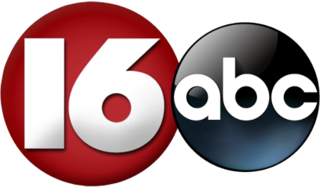
WAPT is an ABC-affiliated television station licensed to Jackson, Mississippi, United States. Owned by the Hearst Television subsidiary of Hearst Communications, it broadcasts a high definition digital signal on UHF channel 21 from a transmitter co-located with its studios on Channel 16 Way in southwest Jackson. On cable, the station can be seen on Comcast Xfinity channel 4, Cable One channel 16 and Vicksburg Video channel 9. There is a high definition feed provided on Xfinity digital channel 431, Cable One digital channel 1016 and Vicksburg Video digital channel 225.
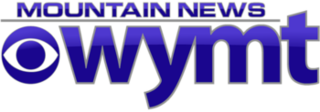
WYMT-TV is a CBS-affiliated television station licensed to Hazard, Kentucky, United States and serving the Eastern Kentucky Coalfield region. Owned by Gray Television, it broadcasts a high definition digital signal on VHF channel 12 from a transmitter south of the city in Perry County.
Night Network, Night Time and Night Shift were names given to the overnight schedule of the ITV network in the United Kingdom. The first ITV company began 24-hour broadcasting in 1986, with all of the companies broadcasting through the night by 1988. At first, individual companies began to create their own services, however before too long, many of the smaller ITV station began simulcasting or networking services from others.
A pirate television station is a broadcast television station that operates without a broadcast license. Like its counterpart pirate radio, the term pirate TV lacks a specific universal interpretation. It implies a form of broadcasting that is unwelcome by the licensing authorities within the territory where its signals are received, especially when the country of transmission is the same as the country of reception. When the area of transmission is not a country, or when it is a country and the transmissions are not illegal, those same broadcast signals may be deemed illegal in the country of reception. Therefore, "pirate TV" can mean many things to many people. Pirate television stations may also be known as "bootleg TV", or confused with licensed low-power broadcasting (LPTV) or amateur television ATV services.
WBEC-TV, virtual channel 63, is an educational independent television station licensed to Boca Raton, Florida, United States. Owned by the Broward County Public Schools district, it is sister to student-run high school radio station WKPX, which features an alternative music format and carries audio broadcasts of the school board's meetings. WBEC-TV's studios and transmitter are located in Davie, Florida. Although the station is based in Broward County, WBEC's city of license, Boca Raton, is located within Palm Beach County.
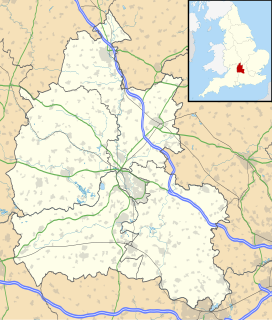
The Oxford transmitting station is a broadcasting and telecommunications facility, situated on land 129.5 metres (425 ft) above Ordnance Datum to the north east of the city of Oxford, in Oxfordshire, England. It has a guyed steel lattice mast which is 154.4 metres (507 ft) in height to the top of the main steel structure. The UHF television antenna, which consist of a vertical array of transmitting panels, is mounted above the steel structure. The total height of the mast to the top of this UHF antenna is 165.7 metres (544 ft). It is owned and operated by Arqiva.
Analogue terrestrial television in the United Kingdom was originally the method by which the significant majority of viewers in the UK, the Channel Islands and the Isle of Man received television. Analogue terrestrial television broadcasts have ceased everywhere in the UK with Northern Ireland being the last region to have ceased broadcasting analogue terrestrial television broadcasts. Northern Ireland switched off the last analogue television signals, making all of the United Kingdom only capable of receiving digital television, in the early hours of 24 October 2012. It has been completely replaced by digital terrestrial television and other non-terrestrial means as of the end of 2012.

A broadcast relay station, also known as a satellite station, relay transmitter, broadcast translator (U.S.), re-broadcaster (Canada), repeater or complementary station (Mexico), is a broadcast transmitter which repeats the signal of a radio or television station to an area not covered by the originating station. It expands the broadcast range of a television or radio station beyond the primary signal's original coverage or improves service in the original coverage area. The stations may be used to create a single-frequency network. They may also be used by an FM or AM radio station to establish a presence on the other band.

UHF television broadcasting is the use of ultra high frequency (UHF) radio for over-the-air transmission of television signals. UHF frequencies are used for both analog and digital television broadcasts. UHF channels are typically given higher channel numbers, like the US arrangement with VHF channels 2 to 13, and UHF channels numbered 14 to 83.
